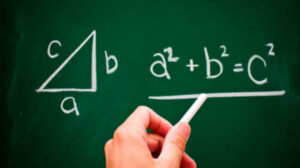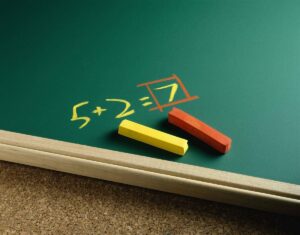Mathematics is considered one of the older, more weighty and difficult components of human culture. The history of arithmetic is connected by a thousand threads with the history of the other sciences. Ethnic wisdom says that it is impossible to grasp the meaning of the present and the goals of the future if you do not understand and appreciate the past and go math 3 grade. Life did not stand still. As the population of the earth grew, so did the need to communicate news to one another, to write, to count, which contributed to the emergence of mathematics. The ancient Greeks were amazingly professional people, something to be learned in modern times. In those eras, Greece consisted of a large number of small states. When a significant municipal issue had to be decided, the people of the city would gather in the square, debate, argue, and then vote. They were not bad “disputants. According to tradition at the time, there was an expression: “Truth emerges in dispute! The Greeks stood out for their diligence and courage. Among them were remarkable builders, sailors, merchants, and painters. They contributed a great deal to the formation of culture and science, especially arithmetic. History shows that the arithmeticians in ancient Greece were the greatest mathematicians in the past, and the problems they compiled are fascinating today. Quite a lot of our school course in arithmetic, much less geometry including 4th grade go math, was widely known to the Greeks. A teacher will not begin a presentation of a fresh topic, let alone a new section of arithmetic, without an introductory historical section that engages the students. Lessons with historical material will leave no one indifferent. How, when introducing students to the basic concepts of 7th grade geometry, do we not talk about Greek mathematics? How does exploring the topic “Area” 8th grade. Just how the connection of historical information with the material of the topic under discussion is grasped. The history of arithmetic is considered a means of increasing students’ cognitive information. And it is the basis of educational work because:
learned in modern times. In those eras, Greece consisted of a large number of small states. When a significant municipal issue had to be decided, the people of the city would gather in the square, debate, argue, and then vote. They were not bad “disputants. According to tradition at the time, there was an expression: “Truth emerges in dispute! The Greeks stood out for their diligence and courage. Among them were remarkable builders, sailors, merchants, and painters. They contributed a great deal to the formation of culture and science, especially arithmetic. History shows that the arithmeticians in ancient Greece were the greatest mathematicians in the past, and the problems they compiled are fascinating today. Quite a lot of our school course in arithmetic, much less geometry including 4th grade go math, was widely known to the Greeks. A teacher will not begin a presentation of a fresh topic, let alone a new section of arithmetic, without an introductory historical section that engages the students. Lessons with historical material will leave no one indifferent. How, when introducing students to the basic concepts of 7th grade geometry, do we not talk about Greek mathematics? How does exploring the topic “Area” 8th grade. Just how the connection of historical information with the material of the topic under discussion is grasped. The history of arithmetic is considered a means of increasing students’ cognitive information. And it is the basis of educational work because:
attention builds thorough and lasting knowledge;
develops and improves the quality of intellectual work and learning, and promotes the formation of abilities;
it increases the sensual field for all psychological processes to take place.
The excursion into history has the possibility of being accompanied by pictures, slides, demonstrations, go math grade 5. Mathematics, since its emergence as a science and much earlier, has been closely linked not only to civilization and practice, but also to human culture and to the world. Mathematical doctrines were developed by certain individuals, mathematicians whose lives and fate, interesting, instructive, at times tragic, are inseparable from the historical times in which they were made.
Let’s talk about Pythagoras, whose name is called the axiom, known to all. In ancient Greece there lived a scientist Pythagoras (he was born within 580 B.C. and died in 500 B.C.). Not enough is known about his life, but a large number of legends are associated with his name. It is said that he traveled extensively, was in India, Egypt, Babylon, and explored ancient culture and the merits of science of various countries. After returning to his homeland, Pythagoras organized a circle of young people from the aristocracy. The circle was accepted with gigantic ceremonies followed by endless tests. Any member categorically renounced his own affiliation and vowed to keep the teachings of the founder a secret. For example, in the south of Italy, which during this time was a Greek colony, there was, for example, a Pythagorean high school called the Pythagoreans. The Pythagoreans pursued arithmetic, philosophy, and the natural sciences. They produced a large number of weighty discoveries in mathematics and geometry. The school had a decree according to which the authorship of all mathematical matters was attributed to Pythagoras. Pythagoras was killed in a street battle during a popular uprising.
After his death, students surrounded the name of their own teacher with almost all legends, in consequence it is impossible to deduce the truth about Pythagoras.
Pythagoras’ axiom contains a splendid situation. As it turned out, before Pythagoras it was known to the Egyptians, Babylonians, Chinese and Indians. Confirmation of Pythagoras himself has not reached us. In real time, there are more than 100 proofs. It is likely, in fact, that one of them belongs to Pythagoras and his students.
Archimedes is the pinnacle of scientific thought in the ancient world. Archimedes appeared in 287 B.C. in the Greek city of Syracuse, where he lived practically all his own life. His founder was Phidias, court astronomer to the ruler of the city of Heron. Archimedes studied in Alexandria, where the rulers of Egypt, the Ptolemies gathered the best Greek scientists and thinkers, and also founded the world’s largest library.
Doubtful is the story that the lord ordered Archimedes to find out if his crown was made of untainted gold or if the jeweler had appropriated a share of the gold by alloying it with silver.
Thinking about this problem, Archimedes once went into a bathhouse and, after immersing himself in the tub, discovered that the amount of water sparkling over the edge was exactly the same as the amount of water displaced by his torso. This prompted Archimedes to solve the crown dilemma, and, without long deliberation, he jumped out of the tub and, stripped naked, raced home, shouting loudly about his own discovery:
“Eureka! Eureka!” (Greek: “Found! Found!”).”
During the defense of Syracuse against the Roman forces besieging this city, Archimedes made lifting and throwing machines, and the “incendiary mirror” with which he supposedly burned ships remains a mystery to prospectors.
The surviving mathematical works of Archimedes can be divided into three groups. The works of the first group are timed to confirm theorems about the areas and sizes of curvilinear figures or bodies. These include treatises “On the sphere and cylinder”, “On the measurement of the circle”, “On conoids and spheroids”, “On spirals” and “On the square of a parabola” The 2nd group is made up of cases on the geometrical analysis of static and hydrostatic problems: on the equilibrium of flat figures, on floating bodies. The 3rd group includes all sorts of mathematical works: on the method of mechanical confirmation of theorems, the calculation of grains of sand, the problem of bulls, preserved only in excerpts.
Euclid. The ancient Greek scientist Euclid had works on mechanics, optics, and music. Popular with his own awards in astronomy. Some theorems and fresh proofs are still attributed to Euclid.
Of the writings of Euclid that have come down to us, the most popular are The Beginning, which consists of 15 books. The first book defines the starting points of geometry, and also has the main axioms of planimetry, covering the axiom of the sum of the angles of a triangle and the axiom of Pythagoras. When constructing correct polygons, this name of Euclid resounds again. Book XIII of “Beginnings” is timed to the Platonic bodies, the faithful polyhedrons, whose beauty we admire in stereometry classes. Considering the difficulties of differential and integral calculus in analysis lessons, we talk about the proper ideas behind them by Newton and Leibniz in the 17th century, going back to the method of exhaustion discovered by Euclid and Archimedes.
Thales of Miletus (c. 625-c. 547 B.C.) was an ancient Greek scientist and municipal functionary, the 1st of the 7 Sages. During his own travels he visited Egypt, where he learned about astronomy and geometry.
Tradition says that Thales astonished the Egyptian lord Amasis by measuring the height of one of the pyramids in terms of the volume of the shadow it casts. Thales was the first to substantiate a number of geometrical theorems, viz:
– vertical angles are equal;
– triangles with similar sides and adjoining equal angles are equal;
– angles at the cause of an isosceles triangle are equal;
– the circumcircle divides the circle in half;
– An angle inscribed in a semicircle will always be a right angle.
Thales determined the height of an object by its shadow, the distance to ships by applying the similarity of triangles.
He arranged a number of discoveries in astronomy, established the times of the equinoxes and solstices, and determined the length of the year. Thales was appointed to the group of “7 wise men.”
Eratosthenes of Cyrene (c. 276 – 194 BC) was a versatile scientist: mathematician, astrologer, geographer, historian and philologist. He became famous for his invention of the Eratosthenes Sieve. In his work “Sieve,” Eratosthenes made an authentic way of “sifting” prime numbers. During Eratosthenes’ time, they were written on wax tablets. The numbers were not crossed out, but pierced. Hence the title of the method – sieve. He invented a device – to mechanically solve Delos’s problem (doubling the cube). The 1st measurements of the volumes of the earth were made. Measuring the length of 1/50th of an arc of the Earth’s meridian, Eratosthenes calculated the circumference of the globe and obtained 25 200 stadia, or 39 960 km, which is only 319 km less than the actual value.
There is no doubt about the scientific arithmetic of ancient Greece. None of the peoples of antiquity has not made such a contribution to the development of mathematics, as the people of Greece. Human nature is characterized by a reverence for the past. This reverence, in some cases, generates in students a desire to look at arithmetic as a science through the fog of antiquity, to touch the graying of ancient times, the secrets and riddles of thousands of years…